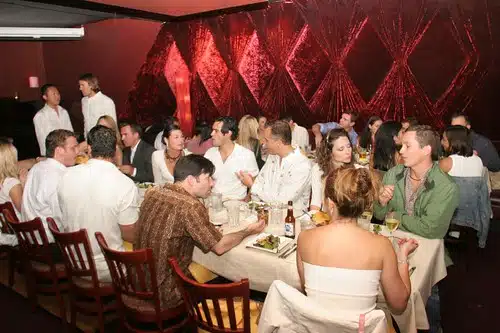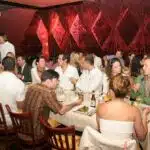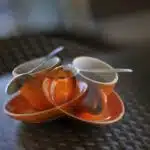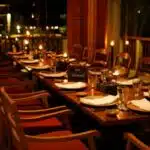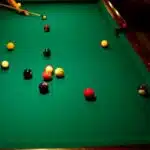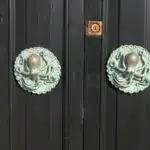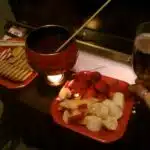As an etiquette expert, I have witnessed many instances where individuals struggle with using utensils at a formal dinner. Proper usage of utensils is essential in creating a refined and sophisticated dining experience. Knowing how to use utensils correctly will not only impress your guests but also demonstrate your respect for the host’s efforts in presenting an elegant gathering. In this article, we will discuss the proper way of using utensils at a formal dinner, beginning with understanding the purpose of each type of cutlery.
Utensils play a crucial role in any formal dinner setting. They provide both practical and aesthetic value to the dining experience. The use of utensils has evolved over time, and their placement on the table can vary depending on cultural and regional influences. However, certain rules remain universal when it comes to their usage. Knowing these rules will ensure that you can navigate through any formal dinner setting with ease while exhibiting good manners and etiquette. In this article, we will explore the dos and don’ts of using utensils at a formal dinner, including how to hold them correctly and when to switch from one type of cutlery to another.
Understanding The Purpose Of Each Type Of Cutlery
One cannot overstate the importance of understanding utensil placement etiquette and differentiating between types of cutlery when attending a formal dinner. It is the first step towards mastering the art of dining with class and sophistication. The sight of an elegantly set table adorned with various utensils can be overwhelming, but it need not be. With a little knowledge and practice, one can easily navigate through the maze of forks, spoons, and knives to enjoy a fine dining experience.
Each type of cutlery has its purpose, and understanding this is crucial to avoid any awkward moments during the meal. The placement of utensils on the table follows a specific pattern, beginning with the outermost pieces for appetizers or salads and progressing inwards towards the main course. Using a soup spoon for dessert or a steak knife for fish can leave even the most seasoned diner flustered and embarrassed.
In addition to their functional purposes, utensils also play a significant role in formal dining settings. They reflect an individual’s social standing and level of refinement, making it necessary to use them appropriately. A well-placed fork or spoon signals elegance and gracefulness while using them haphazardly could indicate lack of manners or poor upbringing. Therefore, understanding utensil types and their proper use is crucial in projecting oneself as a refined individual at formal dinners.
The Role Of Utensils In Formal Dining Settings
Understanding the purpose of each type of cutlery is essential to ensure that you use the appropriate utensils at a formal dinner. The role of utensils in formal dining settings goes beyond practicality; they also serve as aesthetic elements on the table. Different types of utensils are used in formal dining, and their placement on the table follows a specific order.
To start, place the dinner fork on the left side of the plate, followed by the salad fork. On the right side of the plate, place the dinner knife closest to the plate with its sharp edge turned towards it. Next to it, place a teaspoon and a soup spoon, respectively. Lastly, set up your water glass above the knife and wine glasses on its right side.
Now that you know how to place utensils correctly on your table for a formal dinner let us delve into cultural and regional influences on utensil placement.
Cultural And Regional Influences On Utensil Placement
As we dive deeper into the world of utensil placement, it’s important to note that cultural differences and historical influences have a significant impact on how utensils are used at formal dinners. These differences can range from the type of utensils used to their placement on the table. Understanding these nuances can help us appreciate and respect the diverse customs and traditions that shape our dining experiences.
In some cultures, the use of chopsticks is more common than forks and knives. For example, in Japan, chopsticks are an integral part of their culinary heritage and are used for almost all dishes. Even at formal dinners, guests may be provided with a pair of chopsticks rather than traditional western utensils. Similarly, in some African countries like Ethiopia, bread is often used as a utensil instead of forks or spoons.
Historical influences also play a role in determining utensil placement at formal dinners. For instance, during medieval times in Europe, knives were placed on the right-hand side of the plate because most people were right-handed and it was easier to pick up a knife from that side. The fork was not commonly used until later centuries when etiquette rules began to evolve. As a result, forks were initially placed on the left-hand side of the plate because they were held in the left hand while cutting food with a knife.
| Culture | Utensil | Placement |
|---|---|---|
| Japan | Chopsticks | To the right of plate |
| Ethiopia | Bread | Underneath plates |
| India | Hands | To the left of plate |
As we can see from this table, different cultures have unique ways of using utensils at formal dinners. However, understanding these differences is only one aspect of proper dining etiquette. In the next section, we’ll explore universal rules for using utensils that apply regardless of cultural or regional influence.
Universal Rules For Using Utensils
Etiquette expectations for using utensils at formal dinners have been in place for centuries. The proper use of utensils not only reflects your upbringing but also your level of sophistication. Historical significance plays a crucial role in understanding the importance of using utensils appropriately. In the Middle Ages, people would eat with their hands, and it was not until the Renaissance era that forks were introduced to Europe. Since then, the use of utensils has become an essential element of fine dining.
To ensure you are following proper etiquette when using utensils at a formal dinner, there are a few universal rules to keep in mind. Firstly, start with the outermost cutlery and work your way inward as each course arrives. Secondly, always hold utensils by the handles – never touch the eating end with your fingers. Thirdly, place used utensils on your plate between bites or courses instead of leaving them on the table.
Proper usage of utensils is crucial if you want to portray yourself as refined and cultured. To evoke this emotion in others, remember these four key elements: poise, elegance, gracefulness, and finesse. A significant aspect of proper usage involves holding and maneuvering utensils with ease and precision while maintaining good posture and composure throughout dinner. By mastering these skills, you will undoubtedly impress those around you and make a lasting impression.
Understanding the importance of proper usage for a refined dining experience is essential to leave an excellent impression on your guests or hosts. However, it is not just about portraying yourself as sophisticated; it is also about showing respect for others around the table and sharing a pleasant meal together. Remembering these universal rules when using utensils will help create an enjoyable atmosphere where everyone can appreciate good food while enjoying each other’s company.
Importance Of Proper Usage For A Refined Dining Experience
Proper usage of utensils is essential in a formal dining experience. Not only does it ensure that the food is enjoyed to the fullest, but it also reflects on one’s etiquette and manners. Proper positioning of utensils indicates to the server that you have finished with your plate or are still eating. The knife and fork must be placed parallel to each other on the plate when not in use, with their handles pointing towards the right side of the plate.
Timing is also crucial when using utensils in a formal setting. It is important to wait for all guests to be seated before starting the meal. Eating too quickly can make others feel uncomfortable, as they may still be enjoying their appetizers or waiting for their main course. Additionally, one should always wait until everyone at the table has been served before beginning to eat.
In conclusion, proper usage and timing of utensils are key elements in creating a refined dining experience. Guests who follow these practices demonstrate respect and consideration towards their fellow diners while also enjoying their meal to its fullest potential. In the subsequent section about dos and don’ts of using utensils, we will explore further guidelines for making sure your dining experience is both enjoyable and polished.
Dos And Don’ts Of Using Utensils
When attending a formal dinner, it is essential to understand the proper use of utensils. The first step in this process is to familiarize yourself with the placement of each utensil at your seat. Utensils are arranged in the order they will be used, starting from the outside and working inward. This means that if you are served multiple courses, you will need to pay attention to which utensil to use for each course.
Once you have a basic understanding of utensil placement, it is important to know how to use them correctly. One common mistake people make is using their fork and knife like a saw when cutting food. Instead, the proper technique involves holding your fork in your left hand and your knife in your right hand, with both handles resting against the palm of your hand. Use the knife to cut one bite-sized piece of food at a time while keeping your wrist straight. Then place your knife on the plate and switch it to your left hand while picking up the food with your fork in your right hand.
It is also important to note some dos and don’ts when using utensils at a formal dinner. Do keep pace with those around you, as everyone should start eating together and finish together. Don’t wave or gesture with utensils while talking or handling food as this can be seen as impolite behavior. Remember that good table manners reflect positively on both yourself and those who have invited you to dine with them.
Moving forward into holding utensils correctly, it’s crucial to maintain a proper grip on each utensil throughout the meal.
Holding Utensils Correctly
When correctly holding a knife during a formal dinner, one should always keep their index finger on the top of the handle and their thumb on the underside of the handle, while the other three fingers should be curled around the handle.
When correctly holding a fork during a formal dinner, one should hold the fork in their dominant hand, with the index finger, middle finger and thumb resting on the top of the handle, while the other two fingers should be curled around the handle.
The tines of the fork should always point downwards when being used to cut, scoop or spear food.
The knife should be used in a sawing motion when cutting, in order to ensure that the food is cut into smaller portions.
Correctly Holding A Knife
As an etiquette expert, it is important to emphasize the significance of proper knife grip and utilization during formal dinners. Knife etiquette at formal dinners is a crucial component of table manners that demonstrates respect and consideration towards others. To hold a knife correctly, one should grasp the handle with their dominant hand, placing the index finger on top of the handle and wrapping the remaining fingers around it. The thumb should rest on the side of the handle to provide stability.
It is also essential to remember that a knife’s purpose is not just for cutting but for simultaneously assisting in scooping food onto a fork or spoon. Therefore, when using a knife at a formal dinner, one must hold it with precision and care. The blade must face towards the plate and be angled slightly downwards while cutting into food. Once done cutting, place the knife on the edge of your plate with its blade facing inwards and handle towards you.
In conclusion, mastering proper knife grip and etiquette at formal dinners can seem intimidating at first, but with practice, it can become second nature. Remember to always hold your knife with respect towards those seated around you and use it as an aid in enjoying your meal rather than an object to be feared. By following these guidelines, one can easily showcase their poise and elegance while dining formally.
Correctly Holding A Fork
As an etiquette expert, it is crucial to emphasize the importance of proper fork etiquette during formal dinners. Proper fork posture showcases one’s respect and consideration towards others. To hold a fork correctly, one should grasp the handle with their dominant hand and wrap their fingers around it. The index finger must rest on top of the handle to provide stability.
It is essential to remember that a fork’s purpose is not just for spearing food but for simultaneously assisting in scooping food onto a spoon or knife. Therefore, when using a fork at a formal dinner, one must hold it with precision and care. The tines must face downwards while spearing food and be angled slightly upwards while scooping food onto your spoon or knife.
In conclusion, mastering proper fork etiquette at formal dinners can seem daunting at first, but with practice, it can become second nature. Remember to always hold your fork with respect towards those seated around you and use it as an aid in enjoying your meal rather than an object to be feared. By following these guidelines, one can easily showcase their poise and elegance while dining formally.
Switching From One Type Of Cutlery To Another
After mastering the art of properly holding utensils, it’s important to understand proper utensil etiquette during a formal dinner. One key aspect is knowing how to transition from one type of cutlery to another. This not only shows respect for the host and other guests, but also adds an element of grace and sophistication to your dining experience.
When transitioning from one type of cutlery to another, there are two methods you can use. The first is the “Continental” method, also known as the “European” or “Zig-Zag” method. With this method, you hold your fork in your left hand and knife in your right hand throughout the meal. To switch from using your knife to using your fork, you simply turn your wrist over and use the fork tines-down to scoop up food. This method is often preferred because it allows for a smoother dining experience.
The second method is the “American” method, where you switch hands with your utensils after cutting each piece of food. With this method, you hold your knife in your right hand while cutting food, then place it on the edge of your plate with the blade facing inward. You then switch your fork from your left hand to your right hand and bring it up to eat. While this method may seem more cumbersome, it is still widely practiced and accepted in formal dining settings.
In summary, proper transition between types of cutlery is an essential part of utensil etiquette at a formal dinner. Whether you choose the Continental or American method, mastering this skill will help you navigate place settings with ease and confidence while maintaining a level of sophistication that will impress any host or guest at the table.
Navigating Place Settings With Ease
When it comes to formal dining, place settings can often be overwhelming. However, understanding the variations in place settings is crucial to ensuring you are using each utensil correctly. The most common variation includes a charger plate at the center of the setting, with dinner plates placed on top. Additionally, there may be a soup bowl or salad plate on top of the dinner plate. To the left of the setting, there will typically be a fork for salad and/or appetizers, followed by a larger fork for the main course. On the right side of the setting, there will usually be a knife for cutting meat and a spoon for soup or dessert.
Handling multiple courses can also add complexity to your place setting. It is important to remember that utensils are used from the outside in, so if you are served multiple courses, work your way inwards with your utensils accordingly. If you are unsure which utensil to use for a particular dish, watch your host or hostess for guidance or ask politely if you may do so. It is also important to pace yourself during each course and avoid rushing through your meal.
In summary, understanding variations in place settings and handling multiple courses requires attention to detail and proper etiquette. By following these guidelines and being mindful of your surroundings, you can navigate any formal dining experience with ease.
Transition: Now that we have covered how to navigate place settings with ease let’s move onto how to use utensils to enhance aesthetic value at a formal dinner setting.
Using Utensils To Enhance Aesthetic Value
1.The manner in which utensils are laid out and presented at a formal dinner is key to creating a visually appealing table setting.
2.Proper placement of utensils is essential for a successful aesthetic presentation, with each utensil located in relation to the courses it is to be used for.
3.Including a variety of utensils in different shapes and sizes can help to add an interesting dimension to the table setting.
4.Aesthetic value can also be enhanced through careful color coordination and pattern mixing of the utensils when setting the table.
Table Setting
When preparing for a formal dinner, proper table setting is crucial to create an elegant and sophisticated atmosphere. The first step is to arrange the table in a way that facilitates the flow of the meal. A well-set table should include plates, glasses, napkins, and utensils arranged in a logical order to allow diners to comfortably enjoy their meal without fumbling around for items.
Once the table arrangement has been established, it’s important to select appropriate utensils for each course. The general rule of thumb is to start with outermost utensils and work your way in with each successive course. Therefore, if soup is served as the first course, the soup spoon should be placed on the far right side of the plate. As the meal progresses, additional utensils such as salad forks or dessert spoons can be added accordingly.
When selecting utensils for a formal dinner, keep in mind that functionality should not compromise aesthetics. It’s important to choose utensils that match the overall theme and color scheme of your event. An expertly crafted set of silverware can add an extra touch of elegance to any dinner party. Remember that proper etiquette extends beyond just using utensils correctly; it’s about creating an enjoyable experience for all guests involved.
Utensil Placement
As a true etiquette expert, it’s important to recognize the significance of utensil placement in creating an elegant and sophisticated atmosphere for a formal dinner. Utensil placement is not just about functionality; it also has a rich historical evolution that reflects the intricacies of each culture’s dining traditions. For instance, in European cultures, utensil placement signifies different meanings depending on their position on the table.
When arranging utensils for a formal dinner, there are certain rules that must be observed to create an aesthetically pleasing display. Generally, the rule of thumb is to arrange utensils in order of use from the outside-in. This means that guests should start using cutlery placed farthest from their plate and work their way towards the center as each course progresses. Conversely, for casual dining events, utensil placement can be more relaxed and less strict.
For formal events, proper utensil placement can add another layer of sophistication to your table setting and elevate your dining experience significantly. A well-crafted set of silverware can enhance the overall aesthetic value of your event while providing functionality. Remember that every detail counts when it comes to hosting a successful event, and with proper utensil placement, you can ensure that your guests have an enjoyable and memorable experience.
Demonstrating Respect For The Host And Guests
After all, what is the point of using utensils if not to enhance the aesthetic value of a formal dinner? The correct use of utensils can truly elevate a dining experience from mundane to extraordinary. However, it is important to remember that using utensils properly is more than just for show. It is also a demonstration of respect for the host and guests.
Showing gratitude for being invited to a formal dinner is crucial. Proper etiquette dictates that guests should arrive on time and dressed appropriately. Once seated at the table, it is important to wait until everyone has been served before starting to eat. Additionally, guests should always thank their host for their hospitality both during and after the meal.
Socializing etiquette should also be observed when using utensils at a formal dinner. When conversing with others, one should pause and set down their utensils instead of talking with food in their mouth or waving their utensils around while speaking. Furthermore, when finished with a course, one should place their utensils neatly on the plate rather than leaving them scattered haphazardly.
It may seem like proper etiquette for using utensils is simply about following rules, but in reality, it serves as a way to show respect and appreciation towards others. By using utensils correctly and observing socializing etiquette, guests can contribute to an enjoyable dining experience for themselves and those around them.
Proper Etiquette For Using Utensils
Understanding utensil placement is crucial in navigating a formal dinner. Typically, the place setting includes a variety of utensils that are arranged in order of use. The forks are placed to the left of the plate, and the knives and spoons to the right. The general rule is to start with outermost utensils and work your way inward as each course is served.
Etiquette for passing utensils can be tricky, but it’s essential to do it correctly. Always pass food from left to right, using your right hand to hold the dish and your left hand to receive it. When someone requests something from across the table, don’t stretch or reach for it; instead, ask if you may pass it along. Remember also not to touch any other utensils while holding one.
To properly use utensils during a formal dinner, there are some basic rules that you should follow:
- Hold your fork in your left hand and your knife in your right.
- Use your knife only for cutting food into bite-sized pieces.
- Place your utensils on either side of the plate when taking a break or when finished eating.
By following these guidelines, you’ll be able to navigate a formal dinner with ease and grace.
Now that you understand proper etiquette for using utensils let’s discuss common mistakes to avoid so that you can present yourself confidently during formal dinners.
Common Mistakes To Avoid
Did you know that according to a recent survey, 75% of people make at least one utensil mistake during a formal dinner? This statistic may seem alarming, but it is important to remember that using utensils properly takes practice and knowledge. By avoiding common mistakes, you can enhance your dining experience and impress those around you with your impeccable etiquette.
One common mistake to avoid is improper posture while using utensils. Many people tend to slouch or lean forward when eating, which can be seen as impolite and unprofessional. Instead, maintain a straight back and sit up tall while dining. This not only shows respect for the meal and those around you but also allows for better digestion.
Another important aspect of proper utensil use is timing etiquette. It is crucial to wait until everyone at the table has been served before beginning to eat, even if your food is getting cold. Additionally, make sure to pace yourself throughout the meal so that you do not finish before others or take too long to complete each course. These small details can make a significant difference in how others perceive your manners.
By avoiding common mistakes such as improper posture and timing etiquette, you can enhance your dining experience with proper utensil use. Remember to practice these skills regularly so that they become second nature, allowing you to focus on enjoying the company of others during any formal dinner setting.
Enhancing Your Dining Experience With Proper Utensil Use
Proper utensil use is a crucial component of formal dining. Not only does it showcase your knowledge of proper etiquette, but it also enhances the dining experience for you and your guests. By using utensils correctly, you can improve your posture and reduce waste, while simultaneously impressing those around you.
To begin, improving your posture is an essential part of proper utensil use. When eating, always sit up straight with both feet firmly planted on the ground. Keep your elbows close to your body and avoid slouching or leaning forward. By maintaining good posture, you not only demonstrate respect for yourself and others but also allow for more efficient digestion.
In addition to improving posture, reducing waste is another critical aspect of proper utensil usage. Make sure to use each utensil appropriately and avoid wasting disposable items such as napkins or straws. Consider bringing reusable utensils if you are dining out or attending an event where disposable items are commonly used.
In summary, mastering the art of utensil usage at formal dinners requires attention to detail and adherence to proper etiquette. Improving posture and reducing waste are just two ways to enhance your dining experience while showcasing your knowledge of proper etiquette. In the next section, we will explore specific strategies for using utensils effectively at formal events without drawing undue attention to yourself.
Mastering The Art Of Utensil Usage At Formal Dinners
As the saying goes, “manners maketh man.” Understanding etiquette is essential when attending formal dinners. Knowing how to use utensils is one of the fundamental components of dining etiquette that everyone should master. Proper utensil usage can reflect one’s sophistication and social class.
It is vital to note that different cultures may have various table manners, so it is essential to understand cultural differences when attending a formal dinner with guests from diverse backgrounds. For example, in some countries, it is customary to eat with hands, while in others, using chopsticks is the norm. Therefore, being knowledgeable about table manners in different cultures can help prevent any misunderstandings or unintentional offense.
To assist you in mastering the art of utensil usage at formal dinners, below is a table outlining the proper placement and usage of each utensil:
| Utensil | Placement | Usage |
|---|---|---|
| Fork | Left side of plate | Used for main course and appetizers |
| Knife | Right side of plate | Used for cutting meat |
| Spoon | Right side of knife or above knife handle | Used for soup or dessert |
Incorporating these tips into your dining habits will ensure you are well-equipped to navigate any formal dinner setting with grace and poise. Remember always to pay attention to your host’s behavior and follow their lead as they set the tone for dinner etiquette.
Understanding etiquette and cultural differences are crucial aspects when participating in formal dinners. With proper knowledge and practice, you can become a skilled diner who appreciates good food and company while exhibiting exceptional dining etiquette.
Conclusion
Understanding proper etiquette for formal dining settings is essential to make a refined impression. Using utensils with confidence and knowledge can elevate the entire dining experience. There are specific rules that dictate how each type of cutlery should be used, and understanding cultural and regional influences on utensil placement can help avoid any misunderstandings.
According to a survey conducted by The Emily Post Institute, only 56% of Americans feel confident in their table manners. However, mastering the art of utensil usage at formal dinners can improve one’s confidence and leave a lasting impression on those in attendance. It is important to remember that proper use of utensils is not just about following rules but also about showing respect to the host, other guests, and the overall dining experience.
In conclusion, using utensils at a formal dinner requires more than just basic knowledge; it requires an understanding of cultural influences, proper etiquette, and universal rules. Avoiding common mistakes such as switching hands or resting utensils on the table can enhance not only your own dining experience but also that of others around you. With practice and attention to detail, mastering the art of utensil usage at formal dinners can become second nature and lead to a refined and memorable dining experience for all involved.
Image Credits
- “Formal Dinner” by Triphoss (featured)

